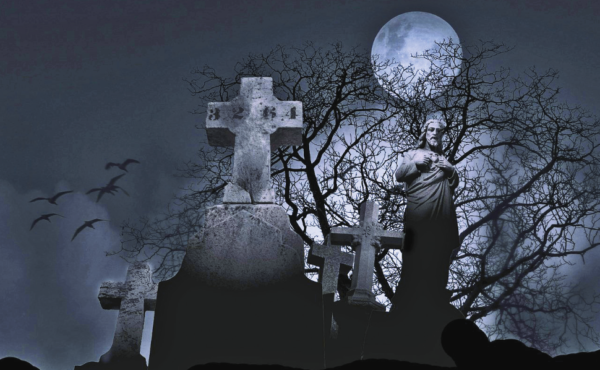
Dark Grave-yard courtesy Needpix.com
Geneva Pattison
Grisly stories of grave robbing have been shared and passed down for eons. These cautionary tales struck fear into the hearts of all who listened, through talk of curses, undead monsters and hauntings associated with the act of robbing a grave.
The very concept of this grim deed disgusted and fascinated people so much, that it inspired works of popular literature, such as Mary Shelley’s Frankenstein.
However, these horror stories were never really works of fiction or lore – much more terrifyingly, many were based on true historical accounts.
There is a detailed examination on the history of this topic, which was originally delivered as a talk given to the Old Dublin Society in 1988. In this talk called, “The Dublin Body Snatchers”, Dr John F. Fleetwood examines the moral versus the scientific, the history of mapping anatomy and how cadavers became currency.
During the 18th and 19th centuries, grave robbers were more commonly known as “resurrectionists” or, by the less romanticised term of “sack-em-ups” as mentioned by Dr Fleetwood. These men would be employed by physicians to secure bodies for medical examination and these bodies were often obtained illicitly.
Existing laws in the 1700’s and 1800’s were grey at best in relation to punishing body snatchers. This was due to an earlier law that was passed in 1540 by Henry VIII, allowing surgeons to anatomise dead felons. The law awarded more freedoms to those who had the means and curiosity to study human anatomy, but also enabled widespread grave robbing to occur.
There was a deficit during this period of time of adequate cadavers for surgeons to study and for teaching medical students. Often, surgeons would bribe people to leave them their bodies after they passed away. Similarly, due to the lack of clarity in law, with regards to proving the origins of a cadaver at the time, people who died on the street were often taken in to be studied.
Dr Fleetwood cites the even more nefarious example of de-ceased orphans being sold on to the surgeons or the sack-em-ups. Despite all this, the Resurrectionists and surgeons knew theft was still a punishable offence. So personal effects, clothing or jewellery belonging to the deceased would be left in the empty grave.
Continuing on, Dr Fleetwood discusses the effects that grave robbing had on the wider community. The prevalence of body snatching incited lifelong fears amongst the living. People would often guard their loved one’s graves or specifically be asked to be buried in the grounds of their homes.
Even Shakespeare himself was wary of physicians stealing his remains as evident from his epitaph, which many consider to be his last great piece of literature. It reads:
“Good friend for Jesus sake forbeare,To dig the dust enclosed here.Blessed be the man that spares these stones,And cursed be he that moves my bones.”
Dr Fleetwood’s talk remarks on the graveyards in Dublin which the resurrectionists usually frequented. One of their favourites was St Andrew’s graveyard on Suffolk St, with bodysnatching accounts there dating back as early as 1732. It was the grave-yard closest to all the main surgical schools and ensured a quick exchange of services could occur, with a swift getaway soon after.
Glasnevin Cemetery was an-other regular haunt for the sack-em-up men. You may be familiar with those famous looming watchtowers in that cemetery and well, they were put there as look-outs for a very specific reason.
The Dublin 4 Resurrectionists and the Wholesale Vampire.
As told by Dr Fleetwood, we learn that Dublin 4 didn’t escape the wave of body snatching taking place all over the county. There is a mid-18th century ac-count of body-snatching that took place in Donnybrook.
On the 4th of September 1750, the Dublin Gazette reported on a number of young surgeons travelling to Donnybrook cemetery to steal the body of a young child who was buried the night before. However, the locals got wind of their plan and the surgeons were met with the wrath of the local community, who eventually re-turned the deceased child to its final resting place.
Our beloved docklands weren’t safe from the scourge of body-snatching either. It seems that the river Liffey was used as a means to transport some ‘unusual goods’ on occasion.
Dr Fleetwood examines the early 1800’s case of a regular anonymous contributor, named only as Erinensis, to the medical journal The Lancet, who rigorously criticised the practice of surgeons paying grave robbers for illegally-obtained cadavers.
In the 1829 issue of the journal, Erinensis spoke about the serious issue of bodies being shipped from Ireland’s ports and sent over to England and Scotland for studious dissection. The contributor also brought up the fact that if Irish resurrectionists were being hired from overseas, that there was no way of monitoring the service. How would surgeons in Britain know how the cadavers were obtained?
The argument was that this would lead to the resurrectionists murdering people who they believed wouldn’t be missed, just to make some quick money, as opposed to digging up the recently-deceased. Aside from being a heinous crime, he argued that this prospect would lower the medical profession in the eyes of the public, making them as bad as the body snatchers themselves.
Dr Fleetwood highlights that people were often caught in the act of shipping bodies from the Docklands. One notorious culprit was a prominent figure of complaint in The Lancet article, a Mr William or Wilson Rae, who lived in Irishtown. He was referred to as being a “half pay” Army surgeon who used the Dublin port to smuggle bodies across the pond.
Rae exported the dead to Britain regularly, as they were worth ten times the amount the Irish physicians were offering. He also went against the very nature of the clandestine act by stealing cadavers during the day. The writer of the article, Erinensis, dubbed Rae the “wholesale vampire” among a slew of other creative insults. In 1829, the law caught up to the Irishtown body snatch-er, and Rae was sent to Newgate prison in Cornmarket.
Medical Acts or Monstrous Deeds?
In the final section of Dr Fleet-wood’s talk, he weighs in on the positive and the negative effects that the Resurrectionists had on society, law and medicine.
In 1832, England passed the Anatomy Act, which allowed doctors and practitioners of anatomy studies to obtain a licence from the Home Secretary and from the Chief Secretary for Ireland. Although this gave surgeons and medical teachers more freedom to practice anatomising, it meant that those in receipt of a licence would be forced to take full responsibility should a cadaver be obtained illegally and similarly, should a gravesite be destroyed or desecrated.
This was a grim period of time for those who lived through it. Fear, anger and superstition ran through the veins of the populace. Anyone who disturbed a body, let alone turned over a grave, were the lowest of the low, simply put, they were considered monsters.
However, we wouldn’t have the breadth of understanding we do now without these medical explorations. As Dr Fleetwood remarks, “ruffians, scoundrels, sordid opportunists, call them what you will – They played a part in our medical history.”
This talk, “The Dublin Body Snatchers”, was delivered to the Old Dublin Society on October 26th 1988. It is available to view through the Jstor on-line article database or through the Old Dublin Society.
Jstor link: https://www.jstor.org/stable/30100854



